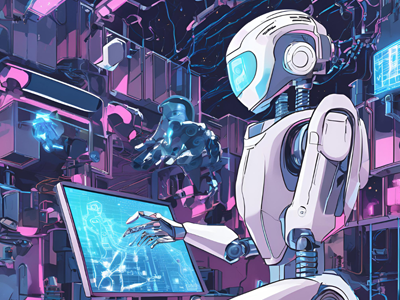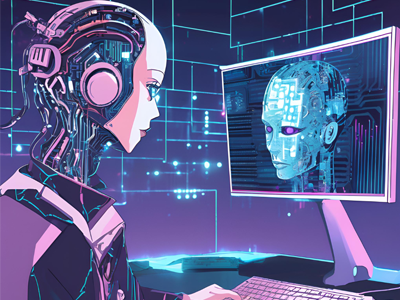Artificial Intelligence, AI is a scientific discipline that was officially presented to the world community in 1956 on a seminar in Hanover, USA. The event was an initiative of four American scientists: John McCarthy, Marvin Minsky, Nathaniel Rochester and Claude Shannon. From its very beginning, the term “artificial intelligence”, probably invented to attract public attention, has become incredibly popular.
The field has gained importance rather steadily in the last sixty years, with much of the intelligent technologies impactful to change the world order. Despite that, the term “artificial intelligence” is a misinterpretation because it is understood as an artificial being with intelligence capable of competing with the best of any human being.
For John McCarthy and Marvin Minsky, AI first meant an attempt to computer model intellectual abilities, human-animal-plant-social-phylogenetic ones. The assumption that all cognitive functions can be described precisely and programmatically reproduced served as the basic of this scientific area. Despite more than sixty years of history, the hypothesis of reproducibility of intellectual functions by computers has not yet been confirmed or disproved definitively, which stimulates scientists to new discoveries.
Modern AI finds its applications in literally every field of life and is very much in a phase of constant development, drawing from an enriched background that was laid down starting mid-twentieth century.
Artificial Intelligence
Artificial intelligence development started just after World War II, when scientists like Alan Turing explored the possibility of machines being able to “think.” In 1950, Turing published “Computing Machines and Intelligence,” where he proposed the Turing Test as a method for determining whether a machine was capable of imitating human intelligence. Artificial intelligence attracted a great deal of attention in the 1960s, spawning the first chess-playing programmes and algebraic problem-solving ones. However, the first “winter period” of AI came in the 1970s, where real-world advances did not quite reach the lofty expectations set by many, and the funding of research was reduced.
Interest in AI took over in the 1980s as a result of a combination of the development of algorithms for machine learning and increased computing power. This era is marked by improvements in the realization of expert systems-which can simulate the decisions of human experts within a particular domain. Starting with the new millennium, a new era of AI had begun, accelerated by developments in the internet, big data, and greater computing power. Breakthroughs in deep learning and neural networks have thus far led to a number of systems now capable of speech and image recognition, underpinning recent work on autonomous cars, personalized medicine, and other applications.
Artificial intelligence is breaking new frames and challenges, finding its place in daily life, and changing many spheres radically: business, medicine, education included. AI history is the way from utopian ideas to real technologies, which inspire scientists and developers to create new things.
Artificial Intelligence has undergone many changes in such a short time since its existence. It is possible to single out six stages in the history of its development.
In the early years of development, encouraged by early successes, a number of researchers including Herbert Simon made optimistic predictions. Simon predicted that “within ten years a digital computer would be the world’s chess champion”. However, when in the mid-1960s a ten-year-old boy defeated a computer at chess and a US Senate report highlighted the limitation of machine translation, progress in AI had slowed significantly. These were considered to be the dark times for AI.
The next one was semantic AI, in which the researcher became interested in the psychology of the memory and comprehension mechanisms. By the mid-1970s, methods of semantic knowledge representation started to appear along with expert systems that made use of skilled knowledge so as to reproduce thought processes. These systems promised very much, especially in medical diagnosis.
In the 1980s and 1990s, the development of machine learning algorithms and bettering technical capabilities resulted in the development of intelligent systems capable of carrying out various tasks such as fingerprint identification and speech recognition. The period was marked by integrating AI into other disciplines for the creation of hybrid systems.
Later in the 1990s, AI began to combine with robotics and a human-machine interface to form something similar to affective computing, which analyses and then reproduces human emotions; this helped in the development of dialogue systems like chatbots.
Since 2010, new opportunities in computing have enabled a marriage of big data with deep learning techniques inspired by artificial neural networks. Advances in speech and image recognition, natural language understanding, and unmanned vehicles are signalling a new AI renaissance.
Artificial intelligence applications
Artificial intelligence technologies have demonstrated great advantages compared to human capabilities in different activities. For example, in 1997, the Deep Blue computer from IBM defeated Garry Kasparov, at the time a world chess champion. In 2016, computer systems defeated the best go and poker players in the world to manifest their capabilities of processing and analyzing huge amounts of data measured in terabytes and petabytes, respectively.
The applications, ranging from recognising speeches to identifying faces and fingerprints from millions of others like those used by secretarial typists, use machine learning techniques. The same technologies permit cars to drive themselves and computers outperforming dermatologists to diagnose melanoma from pictures of moles taken with mobile phones. Military robots and automated assembly lines in factories also make use of the power supplied by artificial intelligence.
In the scientific world, AI has been used to break down the functions of biological macromolecules, including proteins and genomes, according to the order of their components. This separates in silico-from historical methods like experiments in vivo-on living organisms-and in vitro-in laboratory conditions.
The applications of self-learning intelligent systems range from industry and banking to insurance, healthcare, and defence. The automation of numerous routine processes transforms professional activity and makes some professions potentially extinct.
Distinction of AI from neural networks and machine learning
Artificial Intelligence, more commonly referred to as AI, is a general field in computer science that addresses the creation of intelligent machines able to continue activities that usually require human intelligence. It covers, but is not limited to, specialized programs and various technological approaches and solutions. AI makes use of many logical and mathematical algorithms which can be based on neural networks for the purpose of emulating human brain processes.
Neural networks represent a specific kind of computer algorithm, which can be viewed as a mathematical model composed of artificial neurons. Such systems do not require preliminary programming to carry out certain functions. On the contrary, they are capable of learning from previous experience, just like neurons in the human brain create and strengthen their connections during the learning process. Neural networks are tools within AI for the accomplishment of tasks involving recognition or processing of data.
While AI is the general term describing machines that can think and learn like humans, the key subset of AI concerning technologies and algorithms which make programmes learn and improve without human intervention is called machine learning. Such systems analyze input data, find some patterns in it, and use this knowledge to process new information and resolve more complicated problems. One of the methods for organizing machine learning is called neural networks.
Therefore, if we seek to find an analogy of AI within the human body, the AI will act like the entire functioning of the brain, whereas machine learning will be the analogy to information processing and problem-solving techniques, and neural networks will be structural elements-like neurons-which will perform data processing at an atomic level.
Application of AI in Modern Life
AI has found its place in almost every sphere of life in the modern world, starting from commercial use to medical and up to manufacturing technologies. There exist two main types of artificial intelligence: weak and strong. The weak ones are specialized in narrower tasks, like diagnosis or data analysis, while strong AI is created to solve global complex problems deeper by imitating human intelligence.
Big Data analysis with the use of AI finds high applicability in commerce by enabling big commerce platforms to study consumer behaviour and optimise marketing strategies.
Artificial intelligence manufacturing has had its application in monitoring and coordinating workers’ activities, greatly increasing efficiency and safety in the work process. In the transport sector, AI serves in traffic control, monitoring of road conditions, and development and improvement of unmanned vehicles.
The luxury brands are incorporating AI that will perform deep analysis of customers’ needs and personalize products for them. In healthcare, AI is changing the face of diagnostics, development of drugs, health insurance, and even clinical trials, thus making healthcare services a far more accurate and efficient affair.
The reasons for this technological development are rapid growth in information flows, stepped-up investment in the AI sector, and demands for higher productivity and greater efficiency in all sectors. Artificial intelligence continues to expand its influence, penetrating new areas and transforming traditional approaches to business and everyday activities.
Areas of Application of AI
Artificial Intelligence has been covering every other aspect of human life, creating new opportunities for traditional industries to improve efficiency and accuracy.
Medicine and Healthcare: AI operates patient data, analyzes medical images such as ultrasounds, X-rays, and CT scans, and it diagnoses diseases based on symptoms. Intelligent systems give treatment options and help you lead a healthy lifestyle through mobile apps that can monitor your heart rate and body temperature.
Retail and e-commerce: Through AI, users’ online behavior is analyzed to provide recommendations or advertising tailored to them. This also includes the advertisement of products that users viewed in online shops and similar product suggestions based on analyses of user interests. Politics: During presidential campaigns, even that of Barack Obama, AI has been in use for data analysis in order to optimize campaign strategies-choosing where and when to speak-to increase his chances of winning.
Industry: AI helps in controlling manufacturing processes, equipment loads analysis, and demand predictions to ensure proper resource utilization and cost-cutting. Gaming and education: AI generates more realistic virtual opponents, personalized game scenarios in the field of gaming. In education, it is being put to use to plan curricula to suit the needs and capabilities of students, manage educational resources, etc.
Other fields where AI finds application include legal services, finance, and urban infrastructure management, to mention but a few of the areas that really underline its contribution to modern innovation and technological advancement.
Artificial Intelligence (AI) is a scientific discipline that was officially introduced to the world community in 1956 at a workshop in Hanover, USA. The event was initiated by four American scientists: John McCarthy, Marvin Minsky, Nathaniel Rochester and Claude Shannon. Since its inception, the term “artificial intelligence”, probably created to attract public attention, has gained immense popularity.
The importance of AI has grown steadily over the past six decades, with intelligent technologies having a significant impact on changing the world order. Despite its widespread use, the term “artificial intelligence” is often misinterpreted, especially when it is understood to mean an artificial being with intelligence that can compete with humans.
For John McCarthy and Marvin Minsky, AI was first an attempt to computer model intellectual abilities – human, animal, plant, social or phylogenetic. The assumption that all cognitive functions can be accurately described and programmatically reproduced became the foundation of this scientific field. Despite more than sixty years of history, the hypothesis of reproducibility of intellectual functions by computers has not yet been confirmed or disproved definitively, which stimulates scientists to new discoveries.
Modern AI is widely applied in various spheres of life and continues to evolve, building on a rich legacy of research and development that began in the mid-twentieth century.
Development of Artificial Intelligence
The development of artificial intelligence began just after World War II, when scientists such as Alan Turing explored the potential for machines to “think.” In 1950, Turing published “Computing Machines and Intelligence,” proposing the Turing Test as a method of determining a machine’s ability to mimic human intelligence. In the 1960s, artificial intelligence attracted considerable attention, spawning the first programmes for playing chess and solving algebraic problems. However, the 1970s marked the first “winter period” of AI, when real-world advances failed to live up to high expectations, leading to a reduction in research funding.
Interest in AI revived in the 1980s due to the development of machine learning algorithms and increased computing power. This period is characterised by advances in the development of expert systems capable of mimicking the decisions of human experts in certain fields. With the start of the new millennium, AI entered a new era accelerated by the development of the internet, big data and increased computing power. Breakthroughs in deep learning and neural networks have led to the development of systems capable of speech and image recognition, underpinning the development of autonomous cars, personalised medicine and other applications.
Artificial intelligence continues to break new boundaries and challenges, integrating into everyday life and radically changing many spheres, including business, medicine, and education. The history of AI is a path from utopian ideas to real technologies, inspiring scientists and developers to make new discoveries.
Artificial Intelligence (AI) has undergone numerous changes in the short time of its existence. Six stages can be distinguished in the history of its development.
In the early stages of development, fuelled by early successes, researchers such as Herbert Simon made optimistic predictions. Simon envisaged that within ten years, machines could become world chess champions. However, progress slowed in the mid-1960s when a ten-year-old boy beat a computer at chess and a US Senate report pointed out the limitations of machine translation. This period became known as the dark times for AI.
The next stage was directed towards semantic AI, where scientists focused on the psychology of memory and comprehension mechanisms. The mid-1970s saw the emergence of semantic knowledge representation methods and expert systems that used skilled knowledge to reproduce thought processes. These systems showed great promise, especially in medical diagnosis.
In the 1980s and 1990s, the development of machine learning algorithms and technical improvements led to the development of intelligent systems capable of performing a variety of tasks such as fingerprint identification and speech recognition. This period was marked by the integration of AI with other disciplines to create hybrid systems.
By the late 1990s, AI began to be combined with robotics and the human-machine interface, leading to the creation of affective computing aimed at analysing and reproducing human emotions. This trend helped to improve dialogue systems such as chatbots.
Since 2010, new opportunities in computing have made it possible to combine big data with deep learning techniques based on artificial neural networks. Advances in areas such as speech and image recognition, natural language understanding and unmanned vehicles are signalling a new AI renaissance.
Applications of artificial intelligence
Artificial intelligence technologies have demonstrated significant advantages over human abilities in many areas. For example, in 1997, IBM’s Deep Blue computer defeated Garry Kasparov, then world chess champion. In 2016, computer systems defeated the world’s top go and poker players, demonstrating their ability to process and analyse vast amounts of data measured in terabytes and petabytes.
Machine learning techniques are used extensively in applications ranging from speech recognition, similar to the secretarial typists of the past, to accurately identifying faces and fingerprints among millions of others. The same technologies allow cars to drive themselves and computers that outperform dermatologists to diagnose melanoma from pictures of moles taken with mobile phones. Military robots and automated assembly lines in factories are also the result of artificial intelligence.
In the scientific field, AI is used to analyse the function of biological macromolecules such as proteins and genomes based on the sequence of their components. This distinguishes in silico (computer-based experiments using big data and powerful processors) from traditional methods such as in vivo (on living organisms) and in vitro (in laboratory conditions) experiments.
Self-learning intelligent systems find application in almost every sector: from industry and banking to insurance, healthcare and defence. The automation of many routine processes is transforming professional activities and, potentially, making some professions extinct.
Distinguishing AI from neural networks and machine learning
Artificial Intelligence (AI) is a broad field of computer science concerned with the creation of intelligent machines capable of performing tasks that require human intelligence. This includes not only specialised programs, but also a variety of technological methods and solutions. AI uses many approaches, including logical and mathematical algorithms, and can rely on neural networks to mimic the workings of the human brain.
Neural networks are a special type of computer algorithms that represent a mathematical model consisting of artificial neurons. These systems do not require prior programming to perform specific tasks. Instead, they are able to learn based on previous experience and elementary calculations, similar to the way neurons in the human brain form and strengthen connections during the learning process. Neural networks are a tool used within AI to solve tasks related to recognising and processing data.
Machine learning, in turn, is a subset of AI that focuses on developing technologies and algorithms that allow programmes to learn and improve without direct human intervention. These systems analyse input data, find patterns in it and use this knowledge to process new information and solve more complex problems. Neural networks are often used as one of the methods for organising machine learning.
Thus, if we draw an analogy to the human body, AI can be compared to the full functionality of the brain, machine learning would be analogous to information processing and problem solving techniques, and neural networks are structural elements similar to neurons that provide data processing at a fundamental level.
Applications of AI in modern life
Artificial Intelligence (AI) has found widespread application in many different areas of modern life, ranging from commercial applications to medical and manufacturing technologies. There are two main types of AI: Weak AI and Strong AI. Weak AI is specialised to perform specific tasks such as medical diagnosis or data analysis, while Strong AI aims to solve global, complex problems by mimicking human intelligence at a deeper level.
In commerce, AI is being used extensively for Big Data (Big Data) analysis, enabling big commerce platforms to study consumer behaviour and optimise marketing strategies.
In manufacturing, AI is being used to monitor and coordinate the actions of workers, increasing the efficiency and safety of work processes. In the transport industry, AI is helping with traffic management, monitoring road conditions, and developing and improving unmanned vehicles.
Luxury brands are integrating AI to deeply analyse customer needs and personalise products. In healthcare, AI is revolutionising diagnostics, drug development, health insurance and clinical trials, improving the accuracy and efficiency of healthcare services.
This technological advancement is fuelled by the rapid growth of information flows, increased investment in the AI sector and demands for greater productivity and efficiency across all industries. Artificial intelligence continues to expand its influence, penetrating new areas and transforming traditional approaches to business and everyday activities.
Areas of use of AI
Artificial Intelligence (AI) is infiltrating many aspects of everyday life, transforming traditional industries and creating new opportunities to improve efficiency and accuracy:
- Medicine and healthcare: AI is used to manage patient data, analyse medical images such as ultrasounds, X-rays and CT scans, and diagnose diseases based on symptoms. Intelligent systems offer treatment options and help you lead a healthy lifestyle through mobile apps that can monitor your heart rate and body temperature.
- Retail and e-commerce: AI analyses users’ online behaviour to offer personalised recommendations and advertising. This includes advertising products that users have viewed in online shops and suggesting similar products based on analyses of user interests.
- Politics: During presidential campaigns, such as Barack Obama’s, AI was used to analyse data and optimise campaign strategies, such as choosing where and when to speak, increasing his chances of winning.
- Industry: AI helps manage production processes, analyse equipment loads and forecast demand, optimising resources and reducing costs.
- Gaming and education: In the gaming industry, AI is creating more realistic virtual opponents and personalised game scenarios. In education, AI is being deployed to tailor curricula to the needs and abilities of students, and to manage educational resources.
The application of AI spans many other fields, including legal services, finance, urban infrastructure management and more, emphasising its role as a major driver of modern innovation and technological advancement.


















